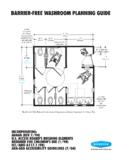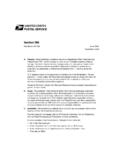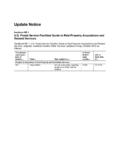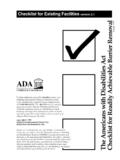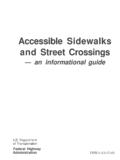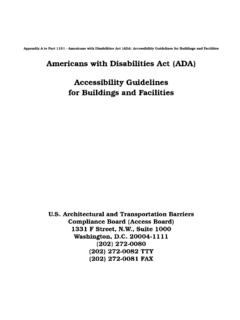Transcription of BARRIER-FREE WASHROOM PLANNING GUIDE - McClain …
1 BARRIER-FREE WASHROOM PLANNING GUIDE . alternate compartment 36" (914mm) 15' - 6" . wide not required, (472cm). provided to create a 36 " 61 " 7' - 0". more universally (927mm) (1562mm) (2134mm). usable WASHROOM enlarged standard compartment 18" (457mm) min., 24" (610mm) preferred 66". 5' - 2". (1676mm). (1575mm). C: 69". (1753mm). 15' - 2" . (462cm). C: 15' - 5" . (470cm). conventional compartment countertop lavatories with knee space and a protective panel below Fig. 18 Small Public WASHROOM Provides Standard Compartment and Alternate Compartment 36" (914mm) Wide. INCORPORATING: ADAAG (REV 7/94). ACCESS BOARD'S BUILDING ELEMENTS. DESIGNED FOR CHILDREN'S USE (1/98). ICC/ANSI (98). ADA-ABA ACCESSIBILITY GUIDELINES (7/04). application of appropriate product specifications and installation criteria. All build- BUILDING ELEMENTS DESIGNED ing plans, however, should be confirmed with local jurisdictions to ensure FOR CHILDREN'S USE job compliance. For public accommodations and commercial facilities, the ADAAG, or a state or local building code that has been certified as equivalent to Final guidelines for making facilities accessible to children have been published ADAAG by the Assistant Attorney General must be used.
2 For state or local gov- by the Access Board ( architectural and Transportation barriers Compliance ernment buildings, either ADAAG or UFAS standards must be used. Since many Board), but not yet adopted by the Department of Justice. While they are not states have adopted all or parts of UFAS, ANSI , or CABO/ANSI. yet enforceable, they offer guidance. Please refer to blue notations beginning into their building codes there will be significant overlap on some with C: in several of the figures. projects. The ADAAG, UFAS, and ANSI standards are similar; however, there are significant differences in the scope of their requirements and some differences in technical specifications. Therefore, unless working from a certified local code, it is imperative that all relevant standards be used in conjunction with this advisory THE GUIDE INCLUDES ICC/ANSI PLANNING GUIDE to ensure legal compliance. The dimensions in this PLANNING GUIDE are taken from the ADAAG.
3 However, because the ICC/ANSI STANDARDS is the least similar in technical specifications to the other standards, ICC/ANSI. dimensions are also shown where they deviate significantly or where complying These standards replace CABO/ANSI which have been adopted by with the ADAAG would not accomplish the same result. Of interest, ICC/ANSI. many states. A transition to the new standards is expected; please check with the WASHROOM requirements tend to be in between ADAAG and appropriate agency in your state. CABO/ANSI 92. THE ADA HAS OPENED THE DOORS THE ADA AND. OF ALL FACILITIES UNIVERSAL DESIGN. The Americans with Disabilities Act (ADA) is a federal civil rights law that The ADA Title III requires all new construction of public accommodations prohibits discrimination against people with disabilities by ensuring them equal and commercial facilities meet or exceed ADAAG specifications. All additions and access to goods and services. It recognizes inaccessible facilities as one form of substantial alterations to functional spaces in existing public accommodations are discrimination, since these facilities can prohibit participation by people with considered new construction and subject to the same ADAAG requirements; and disabilities.
4 The regulations for implementing the ADA include detailed design the entrances, toilet facilities, and accessible routes that service the additions or specifications, originally known as ADA Accessibility Guidelines for Buildings and altered spaces may also have to be brought up to ADAAG standards. Facilities (ADAAG). The Guidelines were developed by the US architectural and Existing public accommodations are required by the ADA Title III to remove Transportation barriers Compliance Board (the Access Board) using sections of barriers that are readily achievable based on an organization's size, resources, the American National Standard for Buildings and Facilities Providing and the type and complexity of the barriers in question. The regulations for the Accessibility and Usability for Physically Handicapped People (ANSI ) law do not precisely define the term readily achievable; however, they do provide and the Uniform Federal Accessibility Standards (UFAS), with additional text for details on how to modify existing buildings and they give building owners logical amplification and some new guidelines.
5 In order to make the ADAAG enforceable, flexibility in coming up with alternative solutions to providing equal services for the Guidelines were subsequently amended and adopted by the US Department people with disabilities if it is deemed that removal of existing barriers is not of Justice as the ADA Standards for Accessible Design (the Standards). The law readily achievable. applies to most buildings and facility types nationwide regardless of state or local Since the ADA mandates widespread accessibility nationwide, it supports the code requirements, but it is not a building code in and of itself. concept of universal design that suggests designers and manufacturers include the While Canada has a single nationwide building code, the United States until necessary characteristics and/or options in all products, building elements, and now has had a federal standard for federal buildings and programs only, and each spaces to ensure that they are usable to the greatest extent possible by people with state and local government has established its own building codes.
6 The ADA has all types and levels of ability. This more universally usable design approach would changed that by setting federal standards for all public accommodations, including include and surpass the minimum requirements of current standards and guidelines. transportation systems, and portions of commercial facilities. Authority has been UNIVERSAL DESIGN can be accomplished in some instances by simply using left with each state and local government to adopt and enforce its own building the same item for everyone; sometimes by positioning an item differently; at other codes, but the office of the Assistant Attorney General for Civil Rights has the times by modifying or replacing a single manufactured feature of an item; and in authority under the ADA to certify that a state or local building code meets or some circumstances by replacing an item with one that is more adjustable or exceeds the minimum requirements of ADA, and such certification of equivalency adaptable.
7 Universal design eliminates radically different looking items and can be used as rebuttable evidence in any subsequent litigation. To help everyone special labels ( , handicapped), and the stigma associated with them, while with legal compliance, the federal government has established Disability and providing choices for all users. Business Technical Assistance Centers (DBTAC) in each region of the country. SPECIAL ISSUE OF LEFT- AND RIGHT-HAND ACCESSIBILITY Some Public washrooms are one of the most critical building amenities with regard people with disabilities can only use certain features if they can approach them to accessibility and function for people with disabilities. With one in four persons from the left or right side. This limitation affects the usability of toilet and shower becoming disabled sometime during their life, washrooms need to be responsive compartments and WASHROOM accessories that are not symmetrical. The ADAAG. to a wide range of human needs and abilities: including people without disabilities standards do not require that both left- and right-handed facilities be available in as well as those using wheelchairs and walking aids, people with sight or hearing all washrooms; however, the concept of universal design suggests that when disabilities, impaired coordination, cardiac or pulmonary disorders, and even people washrooms are planned, both left- and right-handed versions should be provided affected by temporary illness, pregnancy, or advanced age.
8 To the greatest extent possible (see Clear Floor Space on following page). The ADA requires that all washrooms, whether newly constructed or re- modeled, be usable by people with disabilities. This means that some of each type of fixture or feature must meet BARRIER-FREE requirements. Therefore, Bobrick WASHROOM Equipment, Inc. has prepared this GUIDE for use by planners, archi- tects, designers, specifiers, and building owners. In addition, Bobrick's architectural Representatives are available to assist with code interpretation and 2. SPACE FOR PEOPLE IN WHEELCHAIRS IS A. FUNDAMENTAL DESIGN CONSIDERATION. The needs of a person seated in a wheelchair are commonly used as the (Fig. 2b) is also acceptable and may be used to conserve space in some installa- standard of accessibility for BARRIER-FREE washrooms in terms of entrance, exit, tions. A portion of the 60" (1524mm) diameter or T-shaped turning spaces may be and the proximity of equipment.
9 By using the wheelchair perspective you can also located under fixtures, lavatories, or accessories as long as the required knee and accommodate a person using a walker, cane, or crutches. Consideration must also toe clearance is provided (Fig. 4a). be given to the mounting heights of common accessories, such as mirrors, paper Children's Reach Ranges towel dispensers, waste receptacles, soap dispensers, napkin/tampon vendors, Note: Refer to these charts to find the best locations within the given overall and toilet partition-mounted equipment, including grab bars, toilet tissue, and ADAAG ranges that are most appropriate for the specific children's age group seat-cover dispensers, and sanitary napkin disposals. for which you are designing. CLEAR FLOOR SPACE to accommodate a single wheelchair must be at least 30" x 48" (760 x 1219mm). The space can be positioned for a forward or parallel Forward or Side Reach Ages 3 and 4 Ages 5 through 8 Ages 9 through 12.
10 Approach to equipment (see ADAAG ). A portion of the clear floor space may be located under fixtures, lavatories, or accessories as long as the required knee High (maximum) 36" (915mm) 40" (1015mm) 44" (1120mm). and toe clearance is provided (Fig. 4a). If properly centered in front of controls and operating mechanisms, the clear floor space will allow both left- and right- hand access. Floor spaces may have to be wider if elements are placed in alcoves. Low (minimum) 20" (510mm) 18" (455mm) 16" (405mm). MOUNTING HEIGHT REQUIREMENTS for WASHROOM accessories may vary within a facility depending on the location of individual accessories and the direc- Specifications for Water Closets Serving Children Ages 3 through 12. tion of reach required for their use. To allow side reach by people in wheelchairs, it is recommended that accessories be mounted with their dispensing mechanisms, Ages 3 and 4 Ages 5 through 8 Ages 9 through 12. start buttons, coin slots, or dispenser openings located 38" to 54" (965 1372mm).
